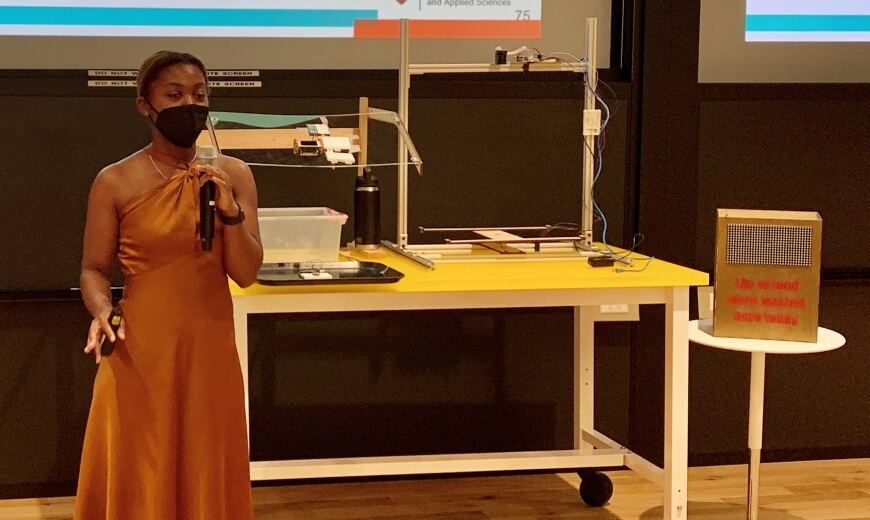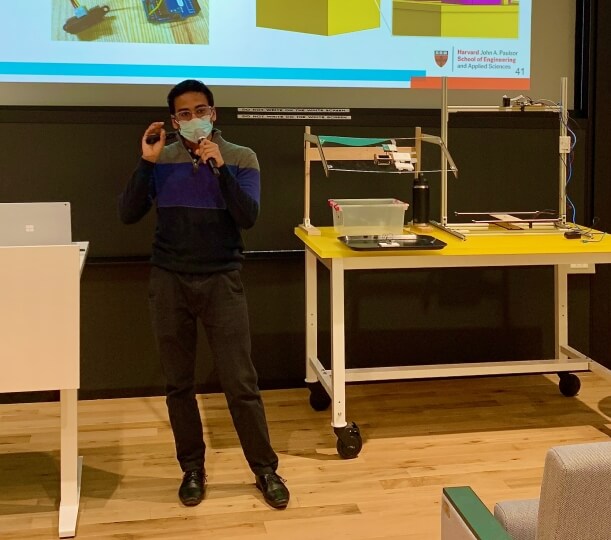News
Each day in the United States, approximately one pound of food per person is wasted. That equated to 103 million tons of food waste in 2017, more than 30 percent of the nation’s food supply, according to the U.S. Department of Agriculture.
A team of students from the Harvard John A. Paulson School of Engineering and Applied Sciences (SEAS) recently took up a challenge from the University’s Office for Sustainability to address the complex cycle of food production, consumption, and waste on campus. The nine third-year students in ES96: Engineering Problem Solving and Design Project presented their end-of-semester solutions on Dec. 7 at the Science and Engineering Complex in Allston.
“Engineering classes that I’d taken before had been very focused on skill sets,” said Kaylee Cornelius, ‘23. “As engineers, we often throw ourselves into the problem at first and automatically start thinking about a fix. This class taught us to take a step back before we start thinking about the solution, think about what we need, and totally understand the problem.”
Kaylee Cornelius, '23, presents her team's prototypes to the Harvard Office for Sustainability at the Science and Engineering Complex in Allston. (Credit: Matt Goisman/SEAS)
The Office for Sustainability tasked Billy Beauregard, Pedro Duarte Moreira, Grace Kim, Catherine Mailly, Bhushan Patel, Jeff Short, Maggie Vallejo, Ariel Wang and Cornelius with addressing and visually representing food system challenges through the lens of institutional procurements. As the students learned about and mapped the complexities of the food system, they created systems maps and a visualization tool to consolidate research into meaningful insights that spanned climate and sustainability goals.
These findings inspired students to further their research to better understand the root cause of food waste in campus dining halls, a topic where they, as key stakeholders, can have an impact. To overcome a lack of granular data for campus food waste, the students designed several prototypes, which included a “portion counter” to better understand how students interact with different food offerings, a “scale and computer vision” system to obtain data on what kinds of food were being wasted, and a display that relayed real time information on food waste that is tracked to the other two prototypes.
“We had three prototypes and three different groups working on the prototypes,” Short said. “A large part of this class is how you’re going to work in a team. You do research because you don’t want to let down your team. You work on the project because you don’t want to let down your team.”
The team’s prototypes used infrared sensors placed above a serving tray to determine how often students grabbed a serving of food, such as a chicken breast or salmon fillet. The sensors paired with Bluetooth devices on individual trays to determine how many portions were going on each tray.
A scale mounted near the disposal conveyor belts then weighed the trays for potential waste. A camera mounted above the scale determined how much of that weight belonged to utensils or plates, and how much belonged to various foods. Once all the data was compiled, a display by the serving stations would indicate how much food was being wasted, in an effort to nudge students before they took food to be more conscientious eaters.
The team tested their prototypes at the Leverett and Quincy Dining Halls. They collected hundreds of images of trays in the disposal area, then used image recognition software to teach their program to distinguish between food waste and utensils.
The team’s solution to the problem of food waste drew a strongly positive reaction from the Office for Sustainability Assistant Director David Havelick and Sustainability Manager Lauren Bloomberg.
“It was outstanding,” Havelick said. “We gave them such a complex challenge, and they addressed it in ways that fit the Harvard environment, but were surprising to us at every turn.”
“I think there are really exciting pilot opportunities,” said Bloomberg “They have been so thoughtful about it, even down to designing it to perfectly match with the conveyor belt.”
Bhushan Patel, '23, presents to the Harvard Office for Sustainability at the Science and Engineering Complex in Allston. (Credit: Matt Goisman/SEAS)
For many students, ES96 was the first course in which they worked in larger groups on a big challenge posed by a real client.
“The technical stuff was actually secondary,” Patel said. “The main part is working in a nine-person team, which is the largest team I’ve ever worked with.”
The class combined technical skills with a holistic approach to problem-solving, where research, ideation and communication, both with one’s peers as well as clients who might not have the same technical background, matter just as much as learning to use new machines or software skills.
“The key for me was to get students to expand their thinking space, and not immediately jump to a solution,” said Julia Lee, Lecturer on Engineering Studies at SEAS and one of three ES96 teachers this semester. “The client framed the problem in a way that lended itself to really great teaching and learning opportunities that extended beyond engineering. We also challenged students to learn and implement new engineering or computation skills as part of the condition for their design considerations. I was impressed that the students, individually and collectively, consistently chose the harder of the options, and with limited time left in the semester.”
Lecturer Jeffrey Paten and Samir Mitragotri, Hiller Professor of Bioengineering and Hansjorg Wyss Professor of Biologically Inspired Engineering, co-taught the course.
“Now, I’m confident that I can look at a problem, dissect it to all the important parts, and realize where I can have an impact,” said Patel.
Topics: Allston Campus, Entrepreneurship, Environment
Cutting-edge science delivered direct to your inbox.
Join the Harvard SEAS mailing list.
Press Contact
Matt Goisman | mgoisman@g.harvard.edu




